|
|
| |
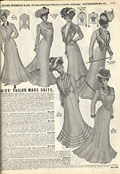 |
|
| |
 Six
dress styles proposed in the Sears-Roebuck (Chicago) Spring Catalogue,
1902, p. 1101. Six
dress styles proposed in the Sears-Roebuck (Chicago) Spring Catalogue,
1902, p. 1101.
|
|
| |
|
|
|
Catalogues and Women's Fashion
by Shirley
Lavertu
Department store catalogues were among the major agents
of
change that affected people's lives. They had considerable influence
over
women and the way they dressed. Bathing suits, girdles, and corsets were
among
the elements that were modified and completely changed women's lives
and
appearance.
Introduction | The
Evolution
of Fashion | The Slim Ideal | How to
Become
Thin | Sun Worshipping | Swimsuits
| The Ageless Woman | From
Corsets to Girdles | Girls' Clothing Modelled on
Women's
| Conclusion | Further
Reading
|
Introduction
In the past few years, the media have often been criticized for their
more
or less positive influence on people's lifestyles and opinions. At
one
time, catalogues tried to dictate behavioural standards in several areas.
Published
by department stores, they were very popular at the end of the 19th
century and
even more so from the 1920s to the 1960s. Catalogue shopping, newspapers,
and
the feminine press in particular, greatly changed women's lives in
both
urban and rural areas. The changes focused on being young and thin,
tanning,
and the power of beauty.
Catalogues had a notable influence on women's consumption
patterns and
especially on the way women dressed. The department stores, including
Eaton's,
Simpson's, and Dupuis Frères, used the catalogues to propose
new
clothing styles. First and foremost, catalogues allowed women to be in
touch
with the world of fashion. Women rarely saw what others wore in the rest
of the
world, or even in their own country, because fashion publications were
found
infrequently in rural homes. The fashion pages in newspapers and a few
magazines
were the only sources of information.
Catalogues were among the publications received by rural women and they
amplified
the influence of fashion. However, despite the vast choice found in
department
store catalogues, rural women did not order much clothing. They preferred
to
buy fabric because there was a much greater variety in catalogues than at
the
general store and the price was lower. In the early part of the century,
the
choice of ready-to-wear clothing was limited, so stores had large
inventories
of fabric. Women made clothing as long as it was less expensive than
buying it
ready-made. By copying the styles in catalogues, they were able to follow
the
trends while keeping costs down. The popularity of ready-to-wear fashion
increased
as the role of catalogues became more important.
|
The Evolution of Fashion
What follows is an overview of a subject that is complex and vast.
Women's
fashion changed drastically from 1900 to 1960. In the early 20th century,
clothing
was supposed to hide the lower part of the body and alter its shape.
Corsets,
hoops, and innumerable petticoats compressed and modified women's
figures.
With time, clothing made the body look more natural and became more
comfortable.
Skirts were gradually shortened. In the early 1930s, dress hems revealed
an ankle
and gave a hint of a long slim leg. Sleeves became shorter and necklines
lower.
Dresses were fairly loose and had a slightly square shape, similar to a
sweater.
Then in the 1940s and 1950s, their shape changed. The top of the dress fit
rather
tightly, while the bottom was wide and full. Skirts remained calf-length,
however.
At that time, corsets made a comeback to make women's waists look
slimmer.
|
The Slim Ideal
| |
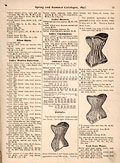 |
|
| |
 Three
styles of corsets sold in Eaton's Spring/Summer Catalogue, 1893,
p. 15. Three
styles of corsets sold in Eaton's Spring/Summer Catalogue, 1893,
p. 15.
|
|
| |
|
|
|
At certain points in history, plump women were considered attractive.
In the
19th and 20th centuries, however, the ideal woman was supposed to be thin.
The
change in the standard of beauty was radical and occurred in two phases.
During
the first phase, in the 19th century and at the turn of the century, the
body
was reshaped to make the waist look very thin. Corsets were promoted to
achieve
that look.
| |
 |
|
| |
 Prima
pills, Dupuis Frères Spring/Summer Catalogue, 1944, p. 77
(centre
left). Prima
pills, Dupuis Frères Spring/Summer Catalogue, 1944, p. 77
(centre
left).
|
|
| |
|
|
|
The catalogues of the period promised that the use of a corset would
give
women an excessively slim waist, making the figure S-shaped when viewed
from
the side. However, corsets caused health problems; they hindered breathing
and
weakened back muscles. This argument, put forth by some reformers, has
been the
subject of several discussions among fashion historians. Corsets deformed
the
body and prevented all natural movement. Women in both urban and rural
areas
discovered these new fashion trends through catalogues and tried to look
like
the models, who were excessively thin. The use of such models increased
sales,
but it also led to greater health problems. Women in rural areas were used
to
work that was more physically demanding and they usually had larger
figures.
As a result, they had to compress their rib cage to a greater degree to
obtain
the ideal slim shape. In doing so, they increased the health risks. In
more conservative
areas, however, some women chose not to wear corsets.
The popularity of corsets decreased from 1920 to 1930, but, in the
second
phase of change, fashion gurus tried to revive them in the 1950s by
promoting
crinolines.
|
How to Become Thin
Catalogues promoted fashion and, in a way, imposed new standards of
beauty
on society. As ideological vehicles, they featured women whose
measurements and
age reflected the aesthetic standards of the period: They were thin,
young, and
beautiful. The means of achieving that were illustrated in the catalogues.
Girdles
and corsets were placed front and centre and, more often than not, several
pages
were devoted to them.
Corsets were available in various styles and fabrics with different
types
of stays to satisfy every taste. And, they came in all sizes: slim,
medium, and
full-figured. Catalogues even offered full-figured women's clothing that
made
them look thinner. In those published for Eastern Canada, the models
usually
met the general criteria of the fashion world: youth, beauty, and
slimness. However,
catalogues for the West featured women with fuller figures who modelled
clothing
that had a slimming effect. The emphasis on slimness was more noticeable
in Eaton's
Toronto catalogue than in the Winnipeg edition, for example. Weight-loss
products
were offered to support women in their quest to be thin. On page 89 of its
fall-and-winter
1934-35 catalogue, for example, Dupuis Frères featured an ad
for
Gomme Lacy's to help women "lose weight safely."
Slim women were considered refined and dignified. This new social
standard
was reflected in the new standard of beauty. Slimness also meant that
women could
afford to buy quality foods such as fruit, which was more expensive.
|
Sun Worshipping
| |
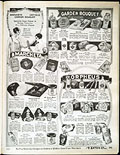 |
|
| |
 Beauty
products for women, Eaton's Spring/Summer Catalogue, 1927, p. 343. Beauty
products for women, Eaton's Spring/Summer Catalogue, 1927, p. 343.
|
|
| |
|
|
|
In the early 20th century, the beauty ideal — fair skin
—was no
doubt inspired by the Victorian era. Starting in the 1920s, tanning became
more
and more popular in Quebec. According to Suzanne Marchand, tanned skin was
a
sign of health and wealth. The practice of tanning became more widespread
as
swimsuits became more popular. However, it was prevalent mainly in urban
areas.
The inhabitants of rural areas were already tanned, since they spent a
good part
of the year working outdoors. In the 1920s, for some people, tanning was a
very
obvious way of showing that they had the means and time to lounge on the
beach.
Given the trend, catalogues began to feature women in swimsuits and offer
products
for sunbathing. Warnings were issued concerning the damaging effects of
overexposure
to the sun, but they were quite informal and were viewed more as a means
of selling
more sunscreen.
|
Swimsuits
| |
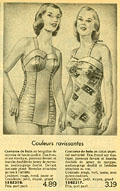 |
|
| |
 Swimsuits
in "delightful colours," in the Dupuis Frères Mid-summer Catalogue,
1953,
p. 4. Swimsuits
in "delightful colours," in the Dupuis Frères Mid-summer Catalogue,
1953,
p. 4.
|
|
| |
|
|
|
The French Canadian Catholic clergy, particularly in Quebec, opposed
the distribution
of catalogues, claiming that they revealed too much of the female anatomy.
The
main target of the battle was the swimsuit because the clergy felt it was
unacceptable
for women to bare their bodies in such fashion. Yet, the first swimsuits
were
quite modest; the skirt was rather long and the top did not have a low
neckline.
Gradually, however, they began to reveal more of the body.
| |
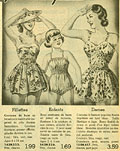 |
|
| |
 Swimsuits
in Dupuis Frères Mid-summer Catalogue, 1951, p. 5. Swimsuits
in Dupuis Frères Mid-summer Catalogue, 1951, p. 5.
|
|
| |
|
|
|
To counter this fashion trend, which was considered indecent, the
Catholic
Women's League was formed in Quebec in 1920. In the 1930s, the
League proposed
a swimsuit model that was approved by the clergy. Dupuis Frères in
Montréal
and Eaton's Toronto sold the model. It is interesting to note that
Dupuis
featured swimsuits in its summer catalogue of 1923. This is all the more
significant
because the company's mail-order service was only a year old. The
models
in the catalogue wore large capes or beach pyjamas that hid most of the
swimsuits.
|
The Ageless Woman
| |
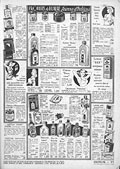 |
|
| |
 Every
woman can be beautiful at any age, so says the Dupuis Frères
Spring/Summer
Catalogue, 1944, p. 77. Every
woman can be beautiful at any age, so says the Dupuis Frères
Spring/Summer
Catalogue, 1944, p. 77.
|
|
| |
|
|
|
As catalogues tried to promote the image of the ageless woman, they
completely
ignored the importance of those who represented wisdom in their milieu
because
of their experience. They continued to feature young models to sell all
types
of clothing, even clothing for older women. Beauty was regularly
associated with
youth. In the West, however, especially in the Eaton's catalogue
published
for that region, mature women modelled certain types of clothing,
including hats.
Catalogues offered a multitude of products for women who wanted to
remain
young: creams, soaps, hair treatments, bras, corsets, clothing that made
them
look younger, etc.
In addition to being ideally slim, women had to look young. Among the
products
available were creams to keep their skin looking young and small red pills
to
help them maintain a youthful rosy complexion. Corsets and girdles allowed
women
of every background to maintain their youthful figures.
Beauty was also widely featured in the catalogues. The women who posed
for
catalogues represented dream images. Catalogues promoted clothing that had
all
the elements needed to make a woman beautiful. The Dupuis Frères
spring-and-summer
catalogue of 1961 advertised "Light and slimming girdles for the
beauty
and youth of your body." [transl.]
|
From Corsets to Girdles
In the 1920s, the waist was no longer emphasized by means of a corset.
However,
corsets did not disappear that easily from women's wardrobes
because, in
the 1940s and 1950s, waistlines were once again highlighted by the use of
crinolines.
At that time, corsets tended to be replaced by bras and girdles, the
latter being
used to compress the hips and lower abdomen while allowing a much greater
freedom
of movement. Panty girdles eventually replaced girdles, but it was not
until
the 1960s that their use became widespread.
In the early 20th century, the corset was a very important item of
clothing
for women, especially in urban areas. Corsets made their waists look slim.
Slimness
was in at the time, but not as much as today, according to some women.
Girls
began wearing corsets when they were young. At first, some complained that
corsets
were not very comfortable, but with time they got used to them.
In rural areas, women wore corsets only on Sunday. It was the preferred
day
for dressing like their urban counterparts. Because of the nature of their
work,
rural women could not afford to be very restricted in their movements.
Two-piece
corsets gave them more freedom but still limited movement.
|
Girls' Clothing Modelled on Women's
Historians have always noticed similarities between women's
clothing
and girls' wear. In the early 20th century, there were differences;
clothing
designed for girls had deeper necklines and shorter sleeves. However,
catalogue
publishers targeted young girls in their corset ads. There were no such
similarities
between the clothing worn by men and young boys, but clothing worn by men
did
resemble that of adolescent boys to a certain extent.
|
Conclusion
Catalogues provoked great change and had considerable influence on
women's
fashion, creating a new market that in turn affected production. Since
mail-order
services allowed people to buy what was featured in catalogues,
consumption patterns
were also significantly transformed.
Women discovered new fashions and trends and catalogues helped them
stay up
to date. Catalogues thus influenced culture, tastes, and consumer choices.
They
made the world of fashion more accessible.
|
|
|
Further Reading
Boucher, François. 20,000 Years of Fashion: The History of
Costume
and Personal Adornment. New York: Harry N. Abrams Inc., 1987. Also
published
in Great Britain under the title A History of Costume in the
West. London:
Thames & Hudson, 1987.
Butazzi, Grazietta. La mode: Art, histoire et
société.
Paris: Le Livre de Paris/Hachette, 1983.
Collectif Clio. Quebec Women: A History, Micheline Dumont, ed.
Toronto:
Women's Press, 1987.
Desanti, Dominique. La femme au temps des années
folles. Paris:
Stock/Laurence Pernoud, 1984.
Deslandres, Yvonne and Florence Müller. Histoire de la mode au
XXe
siècle. Paris: Somogy, 1986.
Leach, William. "Transformation in a Culture of Consumption:
Women and
Department Stores, 1890-1925." Journal of American
History,
71(2) (September 1984): 319-342.
Marchand, Suzanne. Rouge à lèvres et pantalon: des
pratiques
esthétiques féminines controversées au Québec,
1920-1939.
Cahiers du Québec, Ethnologie, no. 116. Montreal: Hurtubise HMH,
1997.
|
| |
|
|